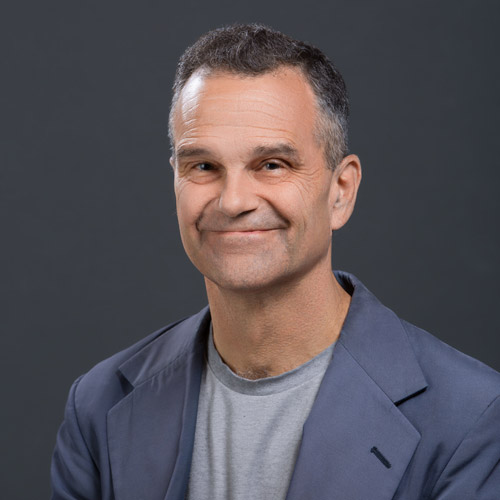Violence, Magic, and Bibleman
CAS’s Frankfurter interested in religion’s practice, not theology

The usual scholarly works of a religion professor on David Frankfurter’s bookshelf share space with some unexpected decorations: action figures ranging from St. Paul to Bibleman, the superhero of an evangelical Christian video series.
Scholarship and pop culture are inextricably linked for the new William Goodwin Aurelio Professor of the Appreciation of Scripture at the College of Arts & Sciences. Less interested in grand theological ideas than in the way religion is popularly practiced, Frankfurter studies rituals, belief in magic (asking saints’ intercession for some earthly goal, for example), “religious kitsch” (hence the action figures), and, more somberly, the link between religion and violence. Specializing in the Christianizing of ancient Egypt, Frankfurter hears dreadful echoes of religion’s violent past in the current debate over the Cordoba Initiative, the group seeking to build an Islamic community center and mosque near Ground Zero in Manhattan.
Educated at Wesleyan, Harvard Divinity School, and Princeton, Frankfurter, who describes his own religious observance as “somewhat practicing Judaism,” comes to BU from the University of New Hampshire. His book Evil Incarnate: Rumors of Demonic Conspiracy and Satanic Abuse in History (Princeton University Press, 2006) won an American Academy of Religion Award for Excellence in the Study of Religion. BU Today sounded Frankfurter out on these issues.
 BU Today: What is the relationship between violence and religion?
BU Today: What is the relationship between violence and religion?
Frankfurter: I’m interested in rituals of violence—what people do to neutralize something they see as dangerous. A ritual might be monks in Egypt chipping away hieroglyphs and images on walls that they viewed as demonic. Another example would be burning of images or blowing them up—what the Taliban did to the Bamiyan Buddhas. Generally, religious violence involves the perception of some people or objects as obstructions to Christ’s return or purity or true religion.
Rituals are deeply embedded. Is it possible to sever the relationship between violence and religion?
No. Religion by its nature helps a group organize what’s sacred and nonsacred, establishes a moral system. It’s always wrestling with how intolerant to be. Youth, when they engage in religiosity, seek moral certainty, but moral certainty involves shunning things that are morally uncertain or polluting. I’m interested in the way in which it works; I have to leave it to liberal pastors and rabbis and imams to figure out the solutions to this kind of thing.
My book on evil was about how people come to imagine others as evil—what kinds of stories come up, how they envision these people.
That implies moderate believers have to come up with alternative narratives and rituals to elbow aside the demonizing ones.
I’m skeptical, because each of these traditions, especially Christianity, has a deeply ingrained demonological tradition, a way of viewing the dangerous “other” as being evil. A lot of these ideas then migrate into secular culture. I’m watching with great worry the debate about this Cordoba center. I’m from Manhattan and recently spent four days in southern Manhattan, and I’m seeing the same sentiments that led to lynchings and synagogue burnings in the 19th and early 20th centuries, the language of fear and impurity—basically bomb language, terrorism language, the same kind of image of one potential building as being a danger, a pollution. The language people are using to oppose it is very, very dangerous. This is the type of language I see through the history of religions as, in the past, mobilizing lynchings and destruction to cleanse the landscape.
Your study would suggest there might be violence to stop construction?
Right. The religious mind-set is that part of collective identity that locates impurity and sacredness.
Is magic’s role in religion positive, neutral, or negative?
We have to be careful about the term, because it’s been used as a way of marginalizing practices we don’t like. As an aspect of religion, I think it’s neutral. There’s a role for the private use of saints, as any Italian grandmother will assure you.
Your science colleagues might say there is ignorance about, and resistance to, science among too many religious believers—those who don’t believe in evolution, for example.
The enemy of scientific education is not magic practices. It’s when religious groups make claims about science—when they say evolution is dangerous to the proper interpretation of Genesis. The same people make false claims about Genesis. The creation story is not meant to be a framework for understanding dinosaurs. And the people opposing scientific education tend to think of themselves as modern and pure of superstitious, magical influences. It’s not the person burying the St. Joseph statue, it’s the fundamentalist Bible-believer.
Rich Barlow can be reached at barlowr@bu.edu.

Comments & Discussion
Boston University moderates comments to facilitate an informed, substantive, civil conversation. Abusive, profane, self-promotional, misleading, incoherent or off-topic comments will be rejected. Moderators are staffed during regular business hours (EST) and can only accept comments written in English. Statistics or facts must include a citation or a link to the citation.